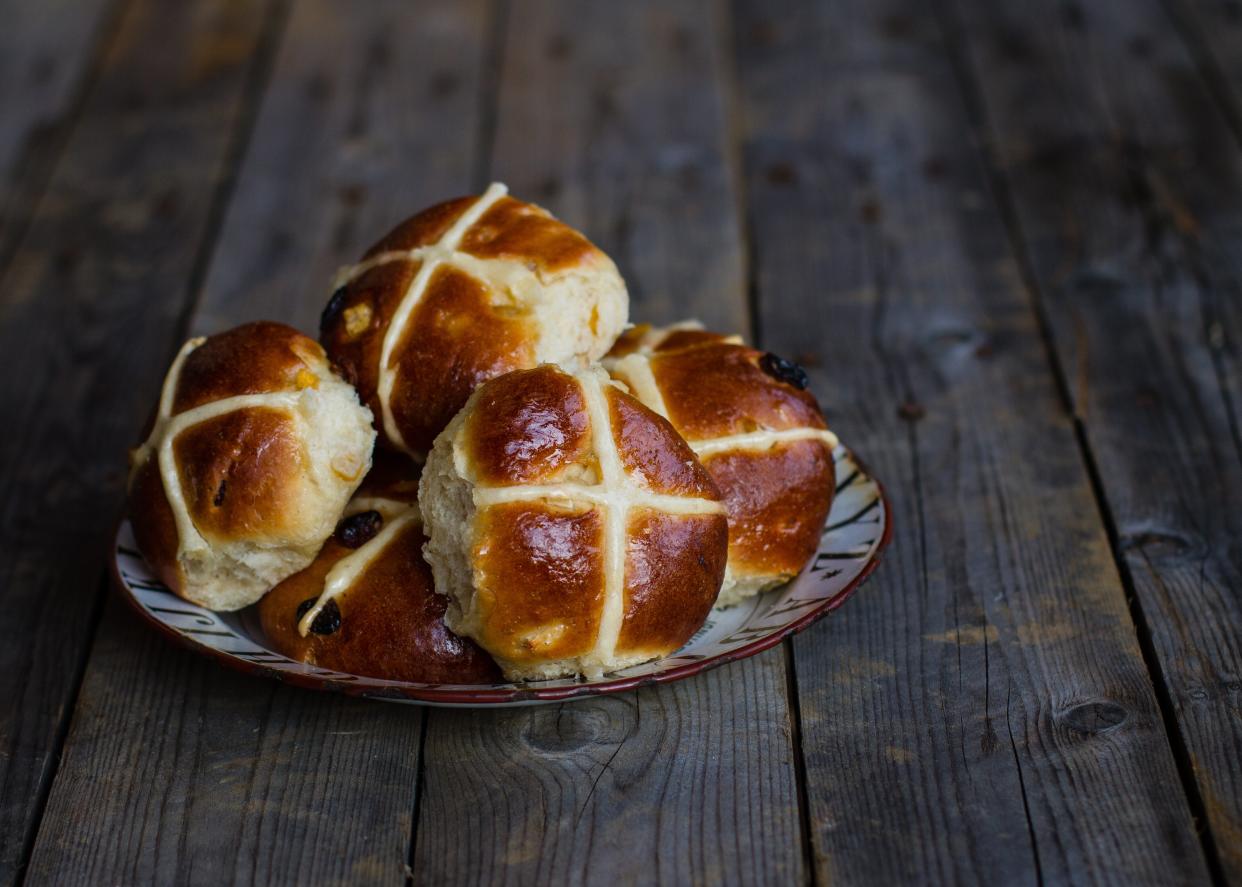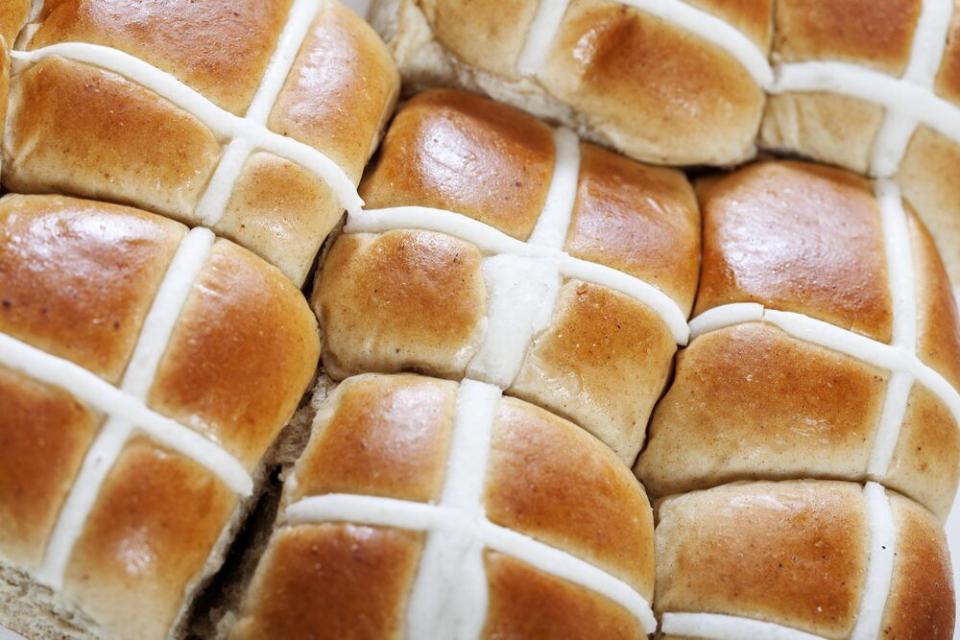What Are Hot Cross Buns and What Do They Have to Do With Easter?

Even if you’ve never eaten a hot cross bun, you’ve likely heard (or learned to play) the song inspired by the festive treat. But what exactly is a hot cross bun—and when did it become associated with Easter?
What Are Hot Cross Buns?
Hot cross buns are spiced, sweet buns made with fruit and marked (either etched into the dough or piped with icing) with a cross on the top. Think of them as a sort of blend between a dinner roll and a sweet pastry.
Most recipes call for raisins and cinnamon, but there are tons of variations out there.
Traditionally, hot cross buns are associated with Easter—a Christian holiday and festival celebrating the resurrection of Jesus—and eaten on Good Friday, or the Friday before Easter.
History and Symbolism

We’re not quite sure where and why hot cross buns became a thing, but a monk at St. Alban’s Abbey in England named Brother Thomas Rodcliffe likely developed a similar recipe in the 14th century.
His creation, called Alban Bun, was distributed to the poor people who lived around the abbey on the Friday before Easter starting in 1361.
However, the history of these sweet buns could go back even further: Archaeologists excavating the city of Herculaneum in southwestern Italy, which had been in ruins since 79 C.E., uncovered two small bread loaves marked with crosses.
In her book Holiday Symbols And Customs, author Sue Ellen Thompson argues that hot cross buns are actually rooted in paganism.
"The pagans worshiped the goddess Eostre by serving tiny cakes, often decorated with a cross, at their annual spring festival,” Thompson wrote.
Like other pagan traditions surrounding spring and new life (like bunnies and eggs, which are historically symbols for fertility and birth), the buns were adopted by Christianity and became associated with Easter.
“The cross is thought to have originally represented the phases of the moon or the four seasons. In the Christian tradition, it now symbolizes the crucifixion and resurrection of Jesus Christ,” according to an article by Kim Vukovich for NPR.
Over time, the buns became more and more intertwined with religious ceremony.
Every part of the buns, according to Christianity by Ina Taylor and Ina Turner, is symbolic: “The cross in the middle shows how Jesus died. Spices inside remind Christians of the spices put on the body of Jesus. Sweet fruits in the bun show that Christians no longer have to eat plain foods.”
The Elizabethan people took them so seriously, in fact, that Queen Elizabeth I passed a law limiting their sale to funerals, Christmas, and Good Friday.
This didn’t limit their popularity, however. Instead of purchasing the buns whenever they wanted, people just began making them in their own homes. Eventually, the law proved too difficult to enforce and was rescinded.
Despite all this, “hot cross buns” weren’t mentioned verbatim until 1733. According to the Oxford English Dictionary, the first reference (printed in Poor Robin’s Almanac) was to a street cry used by bun sellers: “Good Friday comes this Month, the old woman runs/With one or two a Penny hot cross Bunns.”
Hot Cross Buns Song
It was this street cry that inspired the nursery rhyme/song many of us learned in elementary school. The song, which is sung to the tune of "Three Blind Mice," is often played on the recorder.
Plenty of variations of the song exist, but here are some common lyrics courtesy of SongsForTeaching.com:
Hot cross buns,
Hot cross buns,
One a penny,
Two a penny,
Hot cross buns.
If you have no daughters,
If you have no sons,
One a penny,
Two a penny,
Hot cross buns.
If your sons don't like them,
They're the only ones,
One a penny,
Two a penny,
Hot cross buns.
I don't tell jokes
and I don't tell puns,
One a penny,
Two a penny,
Hot cross buns.
Get them while they're hot
and eat them by the ton,
One a penny,
Two a penny,
Hot cross buns.
Superstitions and Traditions
Legend has it that hot cross buns prepared on Good Friday will never spoil.
Another superstition about the mystical bun holds that, because of the cross, they protect against evil spirits—that’s why some bakers used to hang them in their homes. Doing this would supposedly prevent kitchen fires and ensure all bread baked throughout the year would turn out perfectly.
The same principle applies to travel: Taking a batch of hot cross buns on a long voyage was thought to prevent shipwrecks.
Feeling sick? According to some traditions, eating a hot cross bun could help heal an ailing body.
But perhaps the most interesting myth surrounding the treat is that sharing one can create or strengthen a friendship.
"Half for you and half for me, between us two, good luck shall be,” goes an old rhyme, according to IrishCentral.
How to Make Hot Cross Buns

Making hot cross buns is not unlike making other types of sweet buns.
Traditional hot cross buns are made using a shortcrust pastry, which makes carving the cross into the top easier. More recent recipes call for the crosses to be piped on at the end with icing, giving the baker more leeway.
If you have access to one, its best to use a heavy-duty stand mixer to make the rolls—the dough is too sticky to knead by hand.
It’s also important to use flour sparingly. According to our friends at Southern Living, “too much flour will compromise your results. A rainy, humid day will require the full 5 cups of flour; a dry, cool day will take less. Definitely start with the minimum amount.”
Ready to try your hand at making the traditional Easter treat? We’ve got you covered. Our best hot cross buns recipe deserves a spot on your table all year long.

